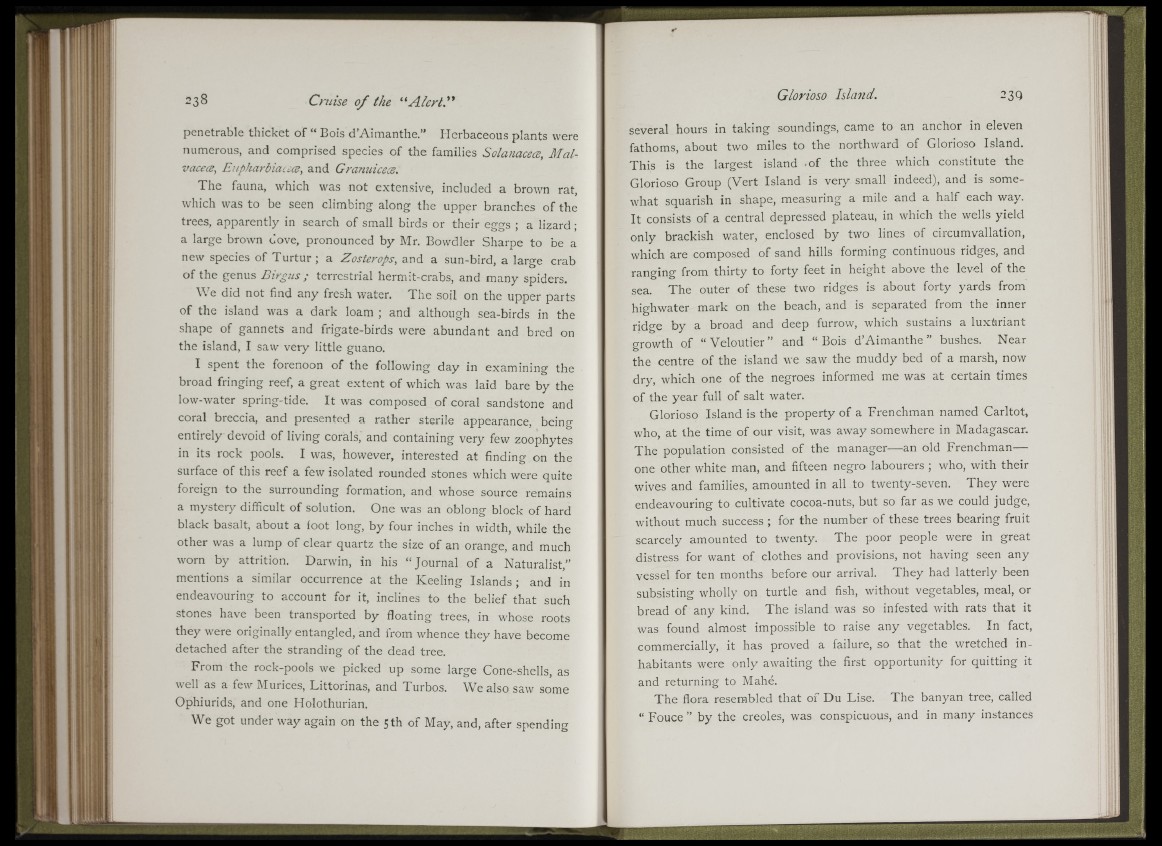
iL
l i ,
i P T .
penetrable thicket of “ Bois d’Aimanthe.” Herbaceous plants were
numerous, and comprised species of the families Solanacece, Malvacece,
Eupharbiaccce, and Granuicece.
The fauna, which was not extensive, included a brown rat,
which was to be seen climbing along the upper branches of the
trees, apparently in search of small birds or their eggs ; a lizard ;
a large brown dove, pronounced by Mr. Bowdler Sharpe to be a
new species of Turtur ; a Zostei'op^, and a sun-bird, a large crab
of the genus Birgns ; terrestrial hermit-crabs, and many spiders.
\\ e did not find any fresh water. The soil on the upper parts
of the island was a dark loam ; and although sea-birds in the
shape of gannets and frigate-birds were abundant and bred on
the island, I saw very little guano.
I spent the forenoon of the following day in examining the
broad fringing reef, a great extent of which was laid bare by the
low-water spring-tide. It was composed of coral sandstone and
coral breccia, and presented a rather sterile appearance, being
entirely devoid of living corals, and containing very few zoophytes
in its rock pools. I was, however, interested at finding on the
surface of this reef a few isolated rounded stones which were quite
foreign to the surrounding formation, and whose source remains
a mystery difficult of solution. One was an oblong block of hard
black basalt, about a foot long, by four inches in width, while the
other was a lump of clear quartz the size of an orange, and much
worn by attrition. Darwin, in his “ Journal of a Naturalist,”
mentions a similar occurrence at the Keeling Islands ; and in
endeavouring to account for it, inclines to the belief that such
stones have been transported by floating trees, in whose roots
they were originally entangled, and from whence they have become
detached after the stranding of the dead tree.
From the rock-pools we picked up some large Cone-shells, as
A\ ell as a few hlurices, Littorinas, and Turbos. We also saw some
Ophiurids, and one Holothurian.
We got under way again on the 5 th of May, and, after spending
several hours in taking soundings, came to an anchor in eleven
fathoms, about two miles to the northward of Glorioso Island.
This is the largest island -of the three which constitute the
Glorioso Group (Vert Island is very small indeed), and is somewhat
squarish in shape, measuring a mile and a half each way.
It consists of a central depressed plateau, in which the wells yield
only brackish water, enclosed by two lines of circumvallation,
which are composed of sand hills forming continuous ridges, and
ranging from thirty to forty feet in height above the level of the
sea. The outer of these two ridges is about forty yards from
highwater mark on the beach, and is separated from the inner
ridge by a broad and deep furrow, which sustains a luxiiriant
crrowth of “ Veloutier” and “ Bois d’Aimanthe o ” bushes. Near
the centre of the island we saw the muddy bed of a marsh, now
dry, which one of the negroes informed me was at certain times
of the year full of salt water.
Glorioso Island is the property of a Frenchman named Carltot,
who, at the time of our visit, was away somewhere in Madagascar.
The population consisted of the manager— an old Frenchman—
one other white man, and fifteen negro labourers ; who, with their
wives and families, amounted in all to twenty-seven. They were
endeavouring to cultivate cocoa-nuts, but so far as we could judge,
without much success ; for the number of these trees bearing fruit
scarcely amounted to twenty. The poor people were in great
distress for want of clothes and provisions, not having seen any
vessel for ten months before our arrival. They had latterly been
subsisting wholly on turtle and fish, without vegetables, meal, or
bread of any kind. The island was so infested with rats that it
was found almost impossible to raise any vegetables. In fact,
commercially, it has proved a failure, so that the wretched inhabitants
were only awaiting the first opportunity for quitting it
and returning to Mahe.
The flora resembled that of Du Lise. The banyan tree, called
“ Louce ” by the creoles, was conspicuous, and in many instances